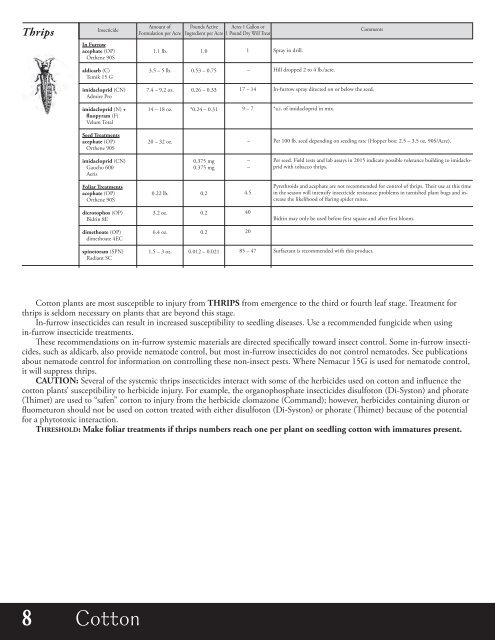Agronomic Crops
mJyPrJ
mJyPrJ
You also want an ePaper? Increase the reach of your titles
YUMPU automatically turns print PDFs into web optimized ePapers that Google loves.
Thrips<br />
Insecticide<br />
Amount of<br />
Formulation per Acre<br />
Pounds Active<br />
Ingredient per Acre<br />
Acres 1 Gallon or<br />
1 Pound Dry Will Treat<br />
Comments<br />
In Furrow<br />
acephate (OP)<br />
Orthene 90S<br />
1.1 lb.<br />
1.0<br />
1<br />
Spray in drill.<br />
aldicarb (C)<br />
Temik 15 G<br />
3.5 – 5 lb.<br />
0.53 – 0.75<br />
–<br />
Hill dropped 2 to 4 lb./acre.<br />
imidacloprid (CN)<br />
Admire Pro<br />
7.4 – 9.2 oz.<br />
0.26 – 0.33<br />
17 – 14<br />
In-furrow spray directed on or below the seed.<br />
imidacloprid (N) +<br />
fluopyram (F)<br />
Velum Total<br />
14 – 18 oz.<br />
*0.24 – 0.31<br />
9 – 7<br />
*a.i. of imidacloprid in mix.<br />
seed treatments<br />
acephate (OP)<br />
Orthene 90S<br />
20 – 32 oz.<br />
–<br />
Per 100 lb. seed depending on seeding rate (Hopper box: 2.5 – 3.5 oz. 90S/Acre).<br />
imidacloprid (CN)<br />
Gaucho 600<br />
Aeris<br />
0.375 mg<br />
0.375 mg<br />
–<br />
–<br />
Per seed. Field tests and lab assays in 2015 indicate possible tolerance building to imidacloprid<br />
with tobacco thrips.<br />
Foliar treatments<br />
acephate (OP)<br />
Orthene 90S<br />
0.22 lb.<br />
0.2<br />
4.5<br />
Pyrethroids and acephate are not recommended for control of thrips. eir use at this time<br />
in the season will intensify insecticide resistance problems in tarnished plant bugs and increase<br />
the likelihood of flaring spider mites.<br />
dicrotophos (OP)<br />
Bidrin 8E<br />
3.2 oz.<br />
0.2<br />
40<br />
Bidrin may only be used before first square and after first bloom.<br />
dimethoate (OP)<br />
dimethoate 4EC<br />
6.4 oz.<br />
0.2<br />
20<br />
spinetoram (SPN)<br />
Radiant SC<br />
1.5 – 3 oz.<br />
0.012 – 0.021<br />
85 – 47<br />
Surfactant is recommended with this product.<br />
Cotton plants are most susceptible to injury from tHRIPs from emergence to the third or fourth leaf stage. Treatment for<br />
thrips is seldom necessary on plants that are beyond this stage.<br />
In-furrow insecticides can result in increased susceptibility to seedling diseases. Use a recommended fungicide when using<br />
in-furrow insecticide treatments.<br />
ese recommendations on in-furrow systemic materials are directed specifically toward insect control. Some in-furrow insecticides,<br />
such as aldicarb, also provide nematode control, but most in-furrow insecticides do not control nematodes. See publications<br />
about nematode control for information on controlling these non-insect pests. Where Nemacur 15G is used for nematode control,<br />
it will suppress thrips.<br />
CAUtIon: Several of the systemic thrips insecticides interact with some of the herbicides used on cotton and influence the<br />
cotton plants’ susceptibility to herbicide injury. For example, the organophosphate insecticides disulfoton (Di-Syston) and phorate<br />
(imet) are used to “safen” cotton to injury from the herbicide clomazone (Command); however, herbicides containing diuron or<br />
fluometuron should not be used on cotton treated with either disulfoton (Di-Syston) or phorate (imet) because of the potential<br />
for a phytotoxic interaction.<br />
tHResHoLD: Make foliar treatments if thrips numbers reach one per plant on seedling cotton with immatures present.<br />
8 Crop Cotton Name


